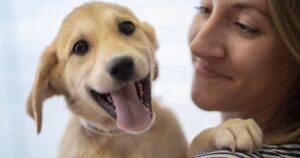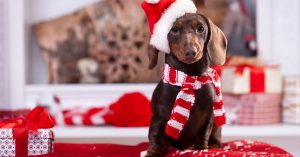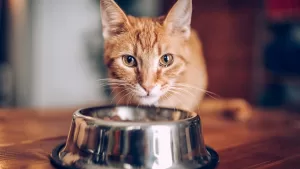Posts by Dr. Lelan Olsen
Why You Should Not Shave Your Dog This Summer
 During the summer, shaving your dog may seem like the obvious choice. It seems like it would help keep them cool during the warming temperatures. However, shaving is not always the best option.
During the summer, shaving your dog may seem like the obvious choice. It seems like it would help keep them cool during the warming temperatures. However, shaving is not always the best option.
Unlike humans, some dogs rely on their coats for temperature regulation. Specifically, the dog breeds that have a double coat. Double coats combine long and stiff guard hairs and short, fluffy dense hairs. This type of coat is familiar to many breeds including retrievers, terriers, and herding breeds. The double coat is waterproof, and protective, and insulates the dog not only from the cold but also from the heat. The fur acts as insulation and helps keep cool temperatures in and hot temperatures out during the summer. Shaving this off can be damaging to your dog’s body temperature regulation.
There are certain circumstances in which a double-coated dog needs shaven. It could be that your dog is older and needs help to self-groom, your dog needs surgery, the dog experienced neglect and has matted hair, and has skin diseases like hot spots or myiasis.
A shaven coat also makes your dog more susceptible to health issues related to the sun. There is a greater risk of sunburn, a greater risk of skin cancer, and a greater risk of heat stroke. When shaving a double-coated dog, the coat may take a long time to recover since the protective guard hairs grow much slower than the fluffy base layer.
If you are concerned still about your double-coated dog dealing with the heat, an alternative to shaving could be consistently brushing your dog with a brush that focuses on the dog’s undercoat. Brushing them consistently will help prevent shedding as well, which will make fur less of an issue for your household.
Overall, it may be possible that your dog just prefers a summer cut, but this is not usually recommended, no matter how hot it gets. If you have any questions, feel free to contact Dr. Olsen at Olsen Veterinary Clinic at 618-656-5868.
Is This Plant Toxic to Dogs? Complete List of Plants Your Dog Should Avoid
 There are plenty of risks to your dog daily. Whether it be cars, other dogs, or something as simple as a plant, it is vital to know the risks that can affect your dog.
There are plenty of risks to your dog daily. Whether it be cars, other dogs, or something as simple as a plant, it is vital to know the risks that can affect your dog.
The most common poisonous plant to dogs is the Sago Palm. This plant is very popular in warmer climates. Every part of this plant is toxic to dogs. This plant is extra dangerous because some dogs find them very delicious and are very attracted to them. The serious side effects of this plant include liver failure and death in some cases.
Another common plant that is toxic to dogs is the tomato plant. When dogs consume this, it can cause weakness, gastrointestinal problems, dilated pupils, slow heart rate, drowsiness, and confusion. Make sure your dog steers clear of this plant to avoid any unnecessary vet visits.
Aloe vera is another summertime plant that is toxic to dogs. The saponins in this succulent can cause vomiting, diarrhea, lethargy, tremors, and general nervous system depression.
Ivy is also quite toxic to dogs, having the capability of causing diarrhea, vomiting, excessive salivation and drooling, and abdominal pain.
The amaryllis bulb is a popular garden ornamental but is poisonous to dogs. Be sure to pay attention to the bulbs if you grow them inside. Similarly, the gladiola flower can cause drooling, vomiting, diarrhea, and lethargy when consumed.
The holly shrub is a low toxicity plant, but your dog could still experience vomiting and diarrhea if eaten.
The daffodil, commonly found in the spring, can cause intestinal spasms, low blood pressure, salivation, tremors, vomiting, diarrhea, and even cardiac arrhythmia if eaten by your dog.
Common in every flower arrangement is the baby’s breath flower. When eaten, this small flower can cause vomiting and diarrhea.
Used to attract butterflies, milkweed is very common and pleasant to look at. However, this flower will induce vomiting and diarrhea, difficulty breathing, rapid and weak pulse, dilated pupils, and even more serious issues such as kidney or liver failure and death.
Common in parks and other large-scale landscaping, the castor bean can cause drooling, vomiting, diarrhea, extreme thirst, loss of appetite, and abdominal pain. It is potentially fatal in severe cases which may present as muscle twitching, tremors, seizures, and even coma.
The azalea or rhododendron flower is poisonous to dogs and produces serious gastrointestinal issues. Additionally, it can cause weakness, discoordination, and weak heart rate. This flower has the potential to be fatal.
Next, the tulip is very popular for gardens but can cause gastrointestinal issues as well as central nervous system depression and even convulsions and death.
Similarly, the chrysanthemum flower can cause vomiting, diarrhea, skin rash, and drooling for your dog if they consume it.
Lastly, the begonia is an extremely common garden flower that is toxic to your dog. It can cause extreme oral irritation and excessive inflammation of the mouth and drooling and vomiting.
Summertime is the time to be outdoors, but that means an increased risk for your pet to accidentally consume something poisonous to them. Be sure to keep an eye on your dog and monitor what they try to eat. If you have any questions or concerns about your pet has, or may have, eaten, contact us today!
Dr. Olsen’s Breed Spotlight: The Peterbald Cat

The Peterbald cat is a loyal and affectionate feline, known for being “dog-like”. They are very friendly, playful, energetic, and smart. The Peterbald is a descendent of the Don Sphynx cat, still bearing some of its qualities like its varying amount of fur, dexterous front paws, big ears, and wrinkly skin. The other feline in a Peterbald cat is the Oriental Shorthair cat. The Peterbald still carries its long and lithe body shape and oblong head shape from them. However, unique to a Peterbald is their long front toes with webbing. It allows them to hold and manipulate toys, unlike many other cats.
The Peterbald’s fur varies from a velvety, fuzzy fur to a completely hairless cat. There is even a type that doesn’t even have whiskers or eyebrows, making their skin feel sticky to the touch. Also interesting is that Peterbald’s fur changes throughout their life. This means that if a Peterbald has one of these coats at birth, it can change significantly during their first two years of life, and the hair can be altered, gained, or lost.
The care of Peterbald cats varies based on their coat. If they have a thin fur coat or no hair at all, they require weekly bathing and wipe downs to keep their skin free of harmful oils. Since Peterbald cats can have very thin coats, they need to be kept as inside cats. Moreover, many Peterbald cats can sunburn, have sensitivity to extreme temperatures, and can be easily injured when playing with other cats or children. But given proper care, these cats are relatively low maintenance and have very few associated breed-health issues.
If you are looking to adopt a Peterbald, know that these cats are still somewhat rare, so acquiring one is not an easy feat. Be sure to check with animal shelters, rescue groups, and reputable breeders to see if a Peterbald is needing a forever home. Since they are often not readily available, it can be difficult to find a Peterbald kitten. Important to note is that hairless cats are often sold for higher prices.
If you have any questions, feel free to contact Dr. Olsen at Olsen Veterinary Clinic at 618-656-5868!
Tips For Socializing Your Dog
 Socializing your dog teaches them how to react to the world around them healthily without any unnecessary fear or aggression. It is important to start socialization early, so it becomes their normal behavior. Ideally, it should be between three and 12 weeks of age, but not everyone is with their furry friend at that point in their life. Beyond 18 weeks, socialization gets a lot harder, but it is not impossible.
Socializing your dog teaches them how to react to the world around them healthily without any unnecessary fear or aggression. It is important to start socialization early, so it becomes their normal behavior. Ideally, it should be between three and 12 weeks of age, but not everyone is with their furry friend at that point in their life. Beyond 18 weeks, socialization gets a lot harder, but it is not impossible.
An important first step is to take your dog out on daily walks in public. This allows your dog to be exposed to many different experiences such as cars, other dogs, and strangers. The world becomes less scary after a few trips outside. Keep them on a short leash and take your dog on different routes to expose them to new sights and smells. Typically, new puppies should be exposed to different places, bodies of water, woods, beaches, and common neighborhood objects like street signs, bikes, strollers, skateboards, and benches.
Related, expose your dog to a wide variety of people such as men, women, and children so that they can get acclimated to the idea of people other than its owners. If your dog isn’t exposed to people other than its owners, it could become wary of anyone who isn’t their owner, so it is crucial to diversify whom your dog interacts with. Included in socialization is allowing your dog to meet unfamiliar people in unfamiliar clothes like hoods, jackets, sunglasses, and hats.
If your dog acts scared, stay calm and confident. Don’t push them, but don’t make a big deal out of their scared behavior. Use treats to give your dog a positive association with new people and experiences.
Socializing your dog allows them to enjoy the world around them and new experiences. To help your dog not fear new surroundings and people, start early, and show them all that your area has to offer! If you have any questions, feel free to contact Dr. Olsen at Olsen Veterinary Clinic at 618-656-5868.
Seatbelts For Dogs – What You Need To Know
 When you get into the car, you think about bucking yourself up. Your dog is most likely not getting their own seatbelt. In fact, 84 percent of pet owners don’t restrain their dogs on car trips according to a survey done by AAA. Even if you think you have the calmest dog in the world, your dog does need a seat belt. It helps keep them and the driver safe.
When you get into the car, you think about bucking yourself up. Your dog is most likely not getting their own seatbelt. In fact, 84 percent of pet owners don’t restrain their dogs on car trips according to a survey done by AAA. Even if you think you have the calmest dog in the world, your dog does need a seat belt. It helps keep them and the driver safe.
When dogs are restrained or contained in the car, they can’t distract the driver as much. According to the CDC, nine people are killed and 1,000 more injured because they were distracted while driving every day. While cell phones are the biggest distracter, your pet can be a major attention grabber too. Roughly two out of three dog owners admit to being distracted by their pup in the car. If you are in an accident, a dog without a seatbelt can turn into a deadly projectile. A ten-pound dog exerts 500 pounds of force during a 50-mph collision while a 60-pound dog becomes a 2,700-pound projectile at 35-mph. Overall, a dog without a seatbelt can cause serious damage in an accident.
Some states require pet restraint laws. So far, only three have laws that require your dog to buckle up in the car, Rhode Island, Hawaii, and New Jersey. Others forbid pets from riding in the back of pick-up trucks or on a driver’s lap. While Illinois does not have any specific pet restraint laws, you can still get a ticket for distracted driving if you get pulled over and your dog is not restrained. The safest place for dogs is in a carrier or harness in the back seat. Just as an airbag can damage a child, the same is for your pet. To get your pet used to a harness, start slowly with five-minute trips, and then expand to ten- and 15-minute rides. Eventually your dog will get used to it. During the outing, be sure to give your dog plenty of praise and a treat after the run.
When you get into the car, you think about bucking yourself up. Your dog is most likely not getting their own seatbelt. In fact, 84 percent of pet owners don’t restrain their dogs on car trips according to a survey done by AAA. Even if you think you have the calmest dog in the world, your dog does need a seat belt. It helps keep them and the driver safe. When dogs are restrained or contained in the car, they can’t distract the driver as much. According to the CDC, nine people are killed and 1,000 more injured because they were distracted while driving every day. While cell phones are the biggest distracter, your pet can be a major attention grabber too. Roughly two out of three dog owners admit to being distracted by their pup in the car.
If you are in an accident, a dog without a seatbelt can turn into a deadly projectile. A ten-pound dog exerts 500 pounds of force during a 50-mph collision while a 60-pound dog becomes a 2,700-pound projectile at 35-mph. Overall, a dog without a seatbelt can cause serious damage in an accident.
Some states require pet restraint laws. So far, only three have laws that require your dog to buckle up in the car, Rhode Island, Hawaii, and New Jersey. Others forbid pets from riding in the back of pick-up trucks or on a driver’s lap. While Illinois does not have any specific pet restraint laws, you can still get a ticket for distracted driving if you get pulled over and your dog is not restrained.
The safest place for dogs is in a carrier or harness in the back seat. Just as an airbag can damage a child, the same is for your pet. To get your pet used to a harness, start slowly with five-minute trips, and then expand to ten- and 15-minute rides. Eventually your dog will get used to it. During the outing, be sure to give your dog plenty of praise and a treat after the run.
It may be tempting to have your dog ride shotgun with you, but for their safety and yours, keep them buckled up in the back. With any questions, feel free to contact Dr. Olsen at Olsen Veterinary Clinic at 618-656-5868!
Can Cats and Birds Cohabitate?
 Cats and birds are natural opposites. Some cats won’t care about birds at all. Other times, the cat’s instinct to pounce, capture, and “play” with the bird will emerge. Either way, if you have a cat and bird cohabitating, it is important to have the proper precautions in place to keep both animals safe and healthy.
Cats and birds are natural opposites. Some cats won’t care about birds at all. Other times, the cat’s instinct to pounce, capture, and “play” with the bird will emerge. Either way, if you have a cat and bird cohabitating, it is important to have the proper precautions in place to keep both animals safe and healthy.
Cats can kill or hurt a bird very easily. With its sharp claws, it can wound the bird and possibly even give it an infection. Cats also pull out important feathers needed for flight, balance, and warmth. They can cause serious mental trauma to a bird that has endured an attack or threat. Cats can even eat small birds. Even though a cat is more dangerous to a bird than a bird is to a cat, bigger birds can seriously hurt a cat. With their strong beaks and claws, they could grab and bite a cat.
Even with the risks, there are ways that you can keep both the cat and bird safe. First, secure the bird cage in a serious manner. Make sure that the cat cannot get inside or knock the bird cage over. Small cages are often placed on tables and are easily knocked over. Make sure the cage is heavy enough that the cat cannot push it around. Be sure to use cage locks or carabiners to make sure the cat cannot open the bird cage doors.
Next, keep them in separate rooms. If you keep the bird cage in a room that the cat is not allowed it, you can avoid the extra stress that a stalking cat can cause for a bird.
Lastly, try and introduce your bird to your cat. It is typically a very slow process, and it starts with allowing your caged bird and cat to see each other from a distance. Eventually, you can lessen the distance between the two after ensuring both are comfortable and not stressed. Some people who have cats that show no signs of going into predator mode will take their bird out of its cage and allow the two to see each other without bars in the way. If you feel comfortable trying this, it must be done with great caution and awareness in case your bird tries to jump out of your hands, or your cat tries to pounce on the bird.
Cats and birds can cohabitate, if the owner takes proper precautions to keep both animals safe and calm. If you have any questions, feel free to contact Dr. Olsen at Olsen Veterinary Clinic at 618-656-5868.
Holiday Pet Gift Guide – 2021
 The holidays are a time for giving, and you can’t forget about your pets or a pet-lover in your life. I’ve assembled a list of the best pet gifts around to show your furry loved ones you care and help them participate in the holiday spirit.
The holidays are a time for giving, and you can’t forget about your pets or a pet-lover in your life. I’ve assembled a list of the best pet gifts around to show your furry loved ones you care and help them participate in the holiday spirit.
The easiest gift is that of more toys for your pet. You can get new toys you think they would like or replace the favorites that always seem to go missing. Here are some cute toy options that your pet would love. Here is a cute Christmas pickle dog toy. Here is a winter rope dog toy. Here is a cute snowman cat toy. Here is a catnip-based reindeer cat toy.
More practical, you could get new essentials like water or food bowls or new leashes. Items like these are always welcome since they get used daily by pets. Here is a nice modern option that is useful and still looks nice in your home. Here is the link.
For a more unique gift, you could get a pet DNA kit to see what their history is as an animal. For some kits, you can learn about their preferences as an individual animal. An example cat DNA test is linked here. Here is a dog DNA test. Here is a pet food and environmental intolerance test to see what bothers your pet.
You could also get your pet a nice jacket to keep them extra warm in the cold winter months. An example one for your dog is linked here. Maybe you’d like a more fun outfit to wear on the special holiday. An example is linked here.
Perhaps your dog likes to stick their head out the window. Some protective goggles for their eyes can be found linked here.
For the pet-lover in your life, you could get them a personalized pin for them to display their furry friend with pride. A handmade pin can be found linked here.
Maybe you are looking to splurge on your pet this winter. If your pet wants to go outside and is not allowed, or maybe they are getting old and can’t move as much as they used to but still wants to enjoy the outdoors, they could use a stroller like this one linked here to enjoy nature. Another splurge item could be this activity monitoring pet tracker. It’ll allow you to stay on top of your pet’s health.
Sharing the season of giving with your pets will only make it more enjoyable. If you have any questions, feel free to contact Dr. Olsen at 618-656-5868 or send him an email here!
Introducing Your Cat To A Newly Adopted Cat: 6 Tips for Success
 Adopting a cat can do a lot of good. You are giving a cat a loving home who may not have had one before. However, if you already have one or more cats at home, introducing a new feline can be tricky. Especially so if the cats have different personality or between a cat that loves being an only-child and a new kitten. To avoid any extra stress, here are six tips to help your cats acclimate.
Adopting a cat can do a lot of good. You are giving a cat a loving home who may not have had one before. However, if you already have one or more cats at home, introducing a new feline can be tricky. Especially so if the cats have different personality or between a cat that loves being an only-child and a new kitten. To avoid any extra stress, here are six tips to help your cats acclimate.
Create a Separate Kitten Space
When bringing a new cat home, the first thing should always be to provide your feline with a safe place. This space gives your cat a sense of familiarity and a place to retreat to if the new house ever gets overwhelmed. This area should be secure from the rest of the house and other felines. In this space, you should have a litter box, food bowl, water bowl, and plenty of toys to keep your kitten occupied when you aren’t home. You should also have safe hiding and sleeping areas for maximum comfort.
Handle Vet Visits Right Away
Part of the adoption process is a regular vet check-up. Schedule your kitten’s first visits to the vet on the same day you plan to bring your cat home. This should include a wellness exam, vaccinations needed, and a discussion about spaying or neutering if your kitten is not already fixed.
In addition, take some time to trim your kitten’s claws and groom its fur before leaving the cat in their designated space. Not only do these tasks help you bond with your new cat, but they also can reduce the risk of stress responses to the presence of the resident cat.
Introduce the Cats Slowly
Cats are very territorial. A new kitten can feel like a threat to your resident cat, so it is important to make new introductions slowly. Anticipate keeping the kitten separate for at least a few days. After the first day or two, give each of your cats an item with the other animal’s scent on it. A blanket, cushion, or fabric toy for example. Place this item in an area where your cat feels comfortable. Avoid specifically approaching either cat with a scented item, as it could be understood as a threat.
Once your cats get used to each other’s scents, you can allow them to interact in limited ways. For example, let them interact through a baby gate or sniff under the door of the other cat’s designated area. Only after your cats begin to behave normally when in proximity to each other should you allow them to meet.
Keep Watch for Any Warning Signs
Change can be extremely upsetting for your cats. Your resident cat may feel like its space is being violated and your new kitten may struggle to get used to a new home and a new sibling at the same time. If either cat gets aggressive, start the introduction process over by separating the cats. This helps your animals and their autonomy and safety feel less threatened.
Stay Patient Through the Introductions
Many cats can learn to live together, but it’s up to you to give them time to get used to the idea. The introduction process should take no less than a week’s time. Before bringing a new cat home, ensure that you have the time and resources to handle this process with care and compassion. You will need to spend dedicated time with both cats to ease the transition and bond.
Understand How to Respond to Aggression
When cats begin to live with each other, they may play fight or compete for attention or toys. For the first few days after your cats are allowed to interact freely, pay attention to their behavior. Normal play may involve a fair amount of batting, pouncing, and so on. If you see threat displays like hissing and arching, distract the cats with a loud noise or toy so that they can retreat. If possible, avoid letting serious physical altercations occur. If necessary, separate the cats until they both calm down. A fight could mean injuries for you and your cats.
Introducing a new cat can be tricky, but with some patience, you can build a happy family with your new felines. Feel free to contact us here or call Olsen Veterinary Clinic at 618-656-5868 with any questions.
What to Do Before Adopting a New Pet
 Adopting a pet is an exciting time for you and your family. However, it can be very overwhelming before your new furry friend comes home. Today, we will be discussing what you should do before your new pet comes to their forever home.
Adopting a pet is an exciting time for you and your family. However, it can be very overwhelming before your new furry friend comes home. Today, we will be discussing what you should do before your new pet comes to their forever home.
First, you should consider your current family. Do you have any other pets? How will they react to bringing in a new pet into the home? You also need to consider how your current home will serve for your new pet. Will your social life or work obligations affect your ability to care for this new pet? How do the other people you live with feel about having a new pet in the house? Are there any health issues that need to be accommodated? What kind of lifestyle do you want to live with your new pet? Are you looking for a dog to go running with or a cat to chill with? Are you in the position to train a pet with behavior issues or are you looking for a more relaxed pet experience? All these questions serve as a guide as to what kind, if any, pet you should adopt. If your current life is not suitable for a pet, maybe it’d be best to wait some time to where you will be more prepared to give your new pet the life they deserve.
More likely than not, the adopting agency will charge a fee to help mediate the costs of taking in unwanted or lost animals. This adoption fee will be a tiny fraction of money compared to how much money you will be spending over the life of your pet. You may also need to pay for your pet to be spayed or neutered before bringing them home. Some mandatory expenses of caring for a pet include food, veterinary care, licensing, collars/leashes/ID tags, cat litter, and grooming supplies. Other expenses that are highly recommended but not mandatory are permanent identification in the form of microchipping, training classes, professional grooming, spare supplies, beds, toys, crates, or carriers. There is also the chance that your furry friend will need emergency veterinary care which can get quite pricy. Before adopting a pet, it is important to make sure that you have the right financial state to be able to care and provide for your pet.
Before bringing your new pet home, you need to make sure that you will have the time to spend on taking care of your pet. Pets need to be fed two to three times a day. A pet parent should spend at least one hour per day giving direct attention to your pet in the form of training, exercising, grooming, or playing with them. A pet with a lot of energy will need more time to exercise and play with toys. Pets with long coats will need twenty minutes per day of grooming to keep their coat silky and not matted. Pets with medical conditions will also need extra attention. In the beginning of your adopted pet being home, they may need additional bonding and reassurance time in the first few weeks.
If you are completely prepared to give your pet the best life possible, the last thing you will need to supply are the necessary items for pet care. For dogs, these are food and water bowls, food, collars, leashes, ID tags, a bed, shampoo, nail clippers, brush/comb, poop baggies, toys, treats, and first aid supplies. For cats, they will need food and water bowls, food, kitty litter, collars, ID tag, carrier, nail clippers, brush/comb, toys, and first aid supplies. It could be best, however, to wait to see the size of your new pet for some of these items, as they will vary based on how big or small your new friend is.
Adopting a pet is an enjoyable yet stressful time in one’s life. Hopefully this list of preparation has made you feel more relaxed and prepared to bring your furry friend home. As always, feel free to contact Dr. Olsen at Olsen Veterinary Clinic at 618-656-5868 with any questions.
What Nutrients Does My Cat Need?
 It can be hard to determine what nutrients you cat needs. There are so many options, and it can be very overwhelming. Each option says you need something different. What is the easiest way to give your cat all of the nutrients it needs?
It can be hard to determine what nutrients you cat needs. There are so many options, and it can be very overwhelming. Each option says you need something different. What is the easiest way to give your cat all of the nutrients it needs?
The simplest way is to make sure that your cat is being fed foods that have an Association of American Feed Control Officials (AAFCO) statement of nutritional adequacy on their labels. It could be something like the sentence, “Animal feeding tests using AAFCO procedures substantiate that Yummy Cat Food provides complete and balanced nutrition for adult maintenance, growth and reproduction, or all life stages” or “Yummy Cat Food is formulated to meet the nutritional levels established by the AAFCO Cat Food Nutrient Profiles for adult maintenance, growth and reproduction, or all life stages”.
Essentially, the AAFCO looks for the proper amounts of each nutrient to keep your cat happy and healthy. These nutrients involve lots of protein as cats are carnivores after all. Protein provides energy, maintain muscle, skin, fur, nails, etc. Cats need animal proteins because their bodies need the nutrients it provides. When a cat eats protein, their digestive tract breaks it down into amino acids, which are then reassembled into the type of protein that the cat needs at that time. Animal protein can be expensive, so some cat food manufacturers keep costs low by including only the minimum amount of protein that cats require to survive, not more to help them thrive. A cats crude protein level should be included in the guaranteed analysis section on the label. To bee nutritionally complete and balanced, AAFCO mandates that a cat food for adult maintenance contain a cat food for adult maintenance contain a minimum of 26% crude protein on a dry matter basis. The minimum for growth and reproduction is 30%.
Another important energy source for cats is fat. Fat and the related fatty acids are parts of ingredients like salmon, chicken, liver, or beef. Sometimes, extra fat is added to foods in the forms of beef fat, fish oil, or soybean oil. The AAFCO minimum for fat in all cat foods is 9% on a dry matter basis. Significantly higher levels of fat may be appropriate for cats who are highly active or have trouble maintaining their weight. Diets designed for weight loss will usually contain less fat in comparison to other foods.
Carbohydrates are less important for cats than they are for humans. A diet containing large amounts of carbohydrates is not natural for cats and may promote weight gain and related health problems. Ideally cats should get less than 10% of their calories from carbohydrates.
Vitamins are necessary in a cat’s diet. Sources include animal tissues, vegetables, fruits, vegetable oils, seeds, and grains. However, it is almost impossible to provide all the vitamins a cat needs at the right levels without including a vitamin supplement in the manufacturing process. If a cat is healthy and eating a nutritionally complete diet, additional vitamin supplementation is not necessary and can be dangerous in some cases. Be sure to discuss with your vet if you think your cat needs supplementation. Related, minerals are another important part of your cat’s diet to help your cat’s body function. Some of the minerals that cats need can come from animal and plant-based ingredients (bone meal, for example), but to be nutritionally complete and balanced, cat food manufacturers almost always must add mineral supplements to their formulas. As long as your cat is healthy and eating a good quality food, you shouldn’t have to add any additional supplementation.
The most important nutrient for cats is water. Water is essential for almost every one of your cat’s metabolic functions. Cats will typically let themselves get dehydrated before they seek out water, so water is necessary in their foods. Some ingredients, like whole meats, are rich in water. Water is also added to commercial cat foods as part of the manufacturing process to facilitate mixing. You may see this on the ingredient list as “water sufficient for processing.” Most of the water is subsequently driven out of dry foods to make them more shelf stable. Generally, cats need about 4 to 5 ounces of water per 5 pounds of body weight, but this includes both water from food and water bowls. Cats who eat canned food may only need to drink very little supplemental water.
If you are feeding your cat a good quality food, your cat is getting its essential vitamins and nutrients. To be even more certain, you can look for an AAFCO certification. As always, if you have any questions, feel free to contact Dr. Olsen at Olsen Veterinary Clinic, 618-656-5868.
